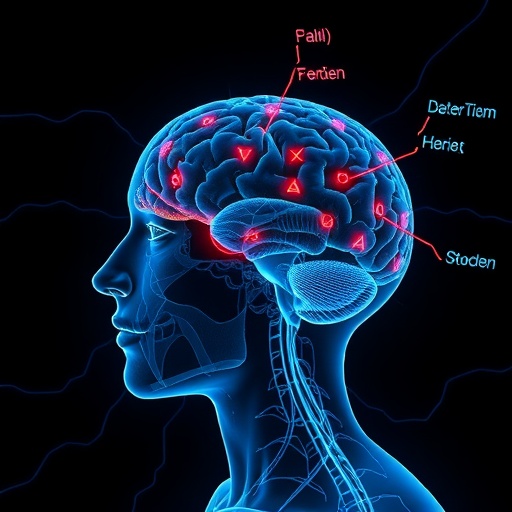In a groundbreaking study published in BMC Psychiatry, researchers have uncovered compelling links between cognitive impairments and serum neurotrophic factor levels in male patients with schizophrenia who have experienced long-term hospitalization. This extensive investigation sheds new light on the neurobiological underpinnings of schizophrenia-associated cognitive deficits and the potential role of neurotrophic factors such as brain-derived neurotrophic factor (BDNF) and glial cell line-derived neurotrophic factor (GDNF) in this process.
Schizophrenia is a complex psychiatric disorder characterized not only by psychotic symptoms but also by profound cognitive dysfunctions that severely impact patients’ daily living and rehabilitation prospects. While cognitive deficits have long been recognized as core features of schizophrenia, especially during chronic phases, the biological mechanisms driving these impairments remain elusive. The current study zeroes in on the relationship between serum neurotrophic factors and cognitive performance, providing novel insights into how these signaling proteins may influence brain functioning in chronically ill patients.
The investigators recruited 82 male patients with schizophrenia who had undergone prolonged hospitalization, a factor often associated with deterioration in cognitive and functional capacities. A control group of 52 healthy males was included for comparative analysis. This large and well-matched cohort allowed for a detailed examination of neurotrophic factor levels and neurophysiological markers alongside a comprehensive battery of cognitive assessments.
Cognitive evaluation encompassed several domains known to be affected in schizophrenia. These included verbal fluency, attention, executive functions, and spatial abilities. The choice of these particular cognitive domains aligns with existing evidence that neurocognitive impairments are widespread but vary in severity across different functions. Verbal fluency tests probe language retrieval and executive control, sustained attention tasks assess concentration and vigilance, while tests of executive function and spatial processing reflect prefrontal and parietal lobe activities, respectively.
Intriguingly, the research team also incorporated recordings of event-related potentials (ERP), focusing on the P300 component. The P300 wave is an established electrophysiological marker linked to attention and working memory processes. Latency and amplitude of the P300 response can reveal subtle abnormalities in stimulus processing and cognitive resource allocation. Utilizing the Nicolet Viking Quest evoked potential system, the researchers meticulously measured P300 parameters, enhancing the physiological relevance of their findings.
The serum levels of BDNF and GDNF were quantified through enzyme-linked immunosorbent assay (ELISA), a sensitive technique permitting precise measurement of these neurotrophic factors in the bloodstream. BDNF is famous for its critical role in synaptic plasticity, neuronal survival, and cognitive function, while GDNF supports dopaminergic neurons and has been explored in neurodegenerative disorders. By analyzing these biomarkers in tandem with cognitive and ERP data, the study aimed to clarify the interplay between peripheral neurotrophic support and brain functional status.
Results were striking: patients displayed universally poorer performance across all tested cognitive domains compared to healthy controls, confirming the substantial cognitive burden in this population. Moreover, P300 latencies were significantly prolonged, and amplitudes reduced in the patient group, suggesting delayed and diminished cortical processing of relevant stimuli. These electrophysiological abnormalities paralleled the cognitive impairment profile, underscoring the functional significance of the observed neurophysiological deviations.
From a biochemical perspective, serum BDNF levels were notably decreased in patients, highlighting potential disruptions in neurotrophic support mechanisms during long-term schizophrenia. In contrast, GDNF concentrations showed no significant difference between groups, shedding light on a more nuanced neurotrophic landscape. These findings imply that while BDNF deficits may underlie the cognitive decline, GDNF’s role requires further scrutiny and might be less directly involved in schizophrenia’s cognitive dimensions.
Importantly, the study revealed specific correlations between neurotrophic factor levels and cognitive test performances. Serum BDNF concentrations were positively associated with digit cancellation and trail making test part B scores, tests which evaluate attention and executive flexibility. Meanwhile, GDNF levels showed a significant correlation with block design test scores, a measure of spatial processing and visuoconstructional abilities. These selective relationships underscore the complex, domain-specific influences neurotrophic factors exert on cognition.
The ERP findings were equally enlightening. The prolonged P300 latency correlated with lower digit cancellation and trail making test part A scores, reinforcing the link between electrophysiological delays and diminished attention and processing speed. Additionally, P300 amplitude correlated with digit cancellation scores, suggesting that cognitive deficits in schizophrenia may stem from both quantitative and qualitative impairment in neuronal signal generation and integration.
These findings carry profound implications for understanding the pathophysiology of chronic schizophrenia. The documented decline in serum BDNF and associated cognitive dysfunctions affirm that neurotrophic deficits contribute to the disease’s cognitive symptomatology. Meanwhile, preserved GDNF levels suggest compensatory or alternative pathways may be involved, warranting deeper investigation into the diverse neurotrophic milieu in schizophrenia.
Moreover, the study highlights the utility of integrating neurophysiological markers such as event-related potentials with biochemical assays to create a multimodal biomarker framework. This approach offers enhanced sensitivity in detecting and characterizing cognitive impairments, potentially enabling better diagnostic precision and treatment monitoring in schizophrenia.
Long-term hospitalization, as seen in the patient cohort, is known to exacerbate cognitive decline due to environmental deprivation, reduced stimulation, and disease chronicity. The present results emphasize the urgent need for therapeutic strategies aimed at bolstering neurotrophic support and cortical plasticity, potentially through pharmacological agents that elevate BDNF or through behavioral interventions that stimulate cognitive engagement and brain resilience.
In conclusion, this pioneering research elucidates critical links between serum neurotrophic factors, cognitive deficits, and cortical processing anomalies in male patients with chronic schizophrenia. The demonstration of diminished BDNF levels alongside specific associations with cognitive performance and P300 electrophysiology opens exciting avenues for future interventions targeting neurotrophic pathways. Ultimately, such insights pave the way toward improved prognosis and quality of life for individuals grappling with this debilitating disorder.
Subject of Research: The relationship between cognitive functions and serum neurotrophic factor levels in long-term hospitalized male patients with schizophrenia.
Article Title: Relationship between cognitive functions and serum neurotrophic factor levels in long-term hospitalized male patients with schizophrenia
Article References:
Jing, P., Yin, X., Yu, H. et al. Relationship between cognitive functions and serum neurotrophic factor levels in long-term hospitalized male patients with schizophrenia. BMC Psychiatry 25, 726 (2025). https://doi.org/10.1186/s12888-025-07173-9
Image Credits: AI Generated




